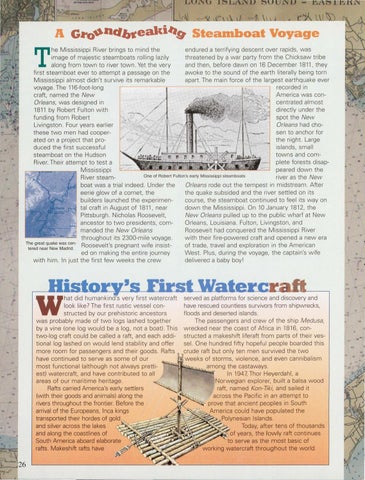he Mississippi River brings to mind the endured a terrifying descent over rapids, was threatened by a war party from the Chicksaw tribe image of majestic steamboats rolling lazily along from town to river town. Yet the very and then, before dawn on 16 December 1811, they first steamboat ever to attempt a passage on the awoke to the sound of the earth lite ra lly being torn apart. The main force of the largest earthquake ever Miss issippi almost didn't survive its remarkable voyage. The 116-foot-long recorded in craft, named the New America was conOrleans, was designed in centrated almost 1811 by Robert Fulton with directly under the funding from Robert spot the New Livingston. Four years earlier Orleans had chothese two men had coopersen to anchor for ated on a project that prothe night. Large duced the first successful islands, sma ll steamboat on the Hudson towns and comRiver. Their attempt to test a plete forests disapMississippi peared down the River steamOne of Robert Fulton's early Mississippi steamboats river as the New boat was a trial indeed. Under the Orleans rode out the tempest in midstream. After the quake subsided and the river settled on its eerie glow of a comet, the builders launched the experimencourse, the steamboat continued to feel its way on tal craft in August of 1811 , near down the Mississ ippi. On 10 January 1812, the Pittsburgh . Nicholas Roosevelt, New Orleans pul led up to the public wharf at New Orleans, Louisiana. Fulton, Livingston, and ancestor to two presidents, commanded the New Orleans Rooseve lt had conquered the Mississippi River "---'--"""'--'"" throughout its 2300-mile voyage. with their fire-powered craft and opened a new era The great quake was cen- Roosevelt's pregnant wife insistof trade, travel and exploration in the American tered near New Madrid. ed on making the entire journey West. Plu s, during the voyage, the captain's wife with him. In just the first few weeks the crew delivered a baby boy!
T
. ..
hat did humankind's very first watercraft served as platforms for science and discovery and have rescued countless survivors from shipwrecks, look like? The first rustic vessel confloods and deserted islands . structed by our prehistoric ancestors The passe ngers and crew of the ship Medusa, was probably made of tw o logs lashed toget her by a vine (one log wou ld be a log, not a boat) . Th is wrecked near the coast of Africa in 1816, contwo-log craft could be called a raft, and each addi- structed a ma keshift liferaft from parts of the ir vestional log las hed on wou ld lend stability and offer sel. One hundred fifty hopefu l people boarded this more room for passengers and their goods . Rafts crude raft but only ten men survived the two weeks of storms, violence, and even cannibalism have continued to serve as some of our most functional (although not always prettiamong the castaways. l'r~~-..:.:-_;; In 1947, Thor Heyerdah l, a est) w atercraft, and have contributed to all Norwegian explorer, built a balsa w ood areas of our maritime heritage . raft, named Kon-Tiki, and sailed it Rafts carried America's early settlers across the Pacific in an attempt to (with their goods and animals) along the prove that ancient peoples in South rivers throughout the frontier. Before the America could have populated the arrival of the Europeans, Inca kings transported their hordes of gold Polynesian Islands. -:;;;;;-~~"!. Today, after tens of thousands and silver across the lakes of years, the lowly raft continues and along the coastlines of to serve as the most basic of South America aboard elaborate rafts. Makeshift rafts have working watercraft throughout the world.
W
"
..
.
•
.
.
..
..
"
